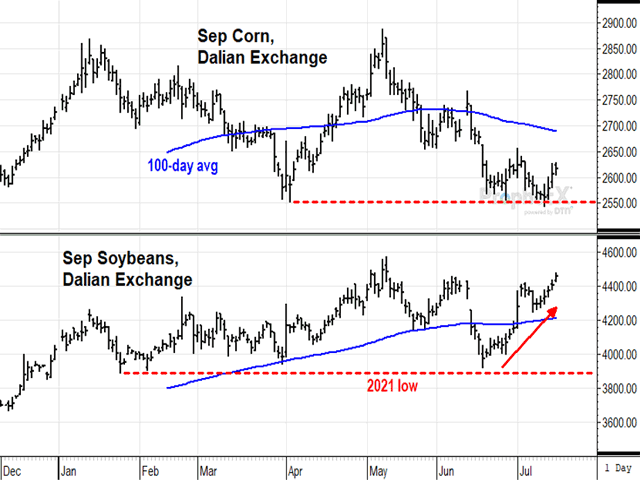Todd's Take
How Much Corn Will China Import?
Nearing the end of the 2020-21 season for U.S. corn, we can easily say the surprise of the year (beyond the pandemic) was China's large corn purchases, ballooning to 26 million metric tons (mmt) or 1.02 billion bushels (bb) from 7.6 mmt or 299 million bushels (mb) the year before. China's 916 mb of purchases from the U.S. are the main reason cash corn prices are currently trading above $6.00 across the Midwest, and USDA now estimates U.S. ending corn stocks at 1.08 bb in 2021-21, down from 1.92 bb the previous season.
Looking ahead, the big question we all want answered is: Will China be back for another billion bushels of corn imports in 2021-22? So far, the answer looks like yes, but there are some factors that could dial the amount modestly lower. According to the Chinese news outlet, Global Times, China's imported 3.16 mmt or 124 mb of corn in May, nearly four times the amount bought a year ago (see "China's May Corn Imports Signal High Demand in 2021" by Zhang Dan at https://www.globaltimes.cn/…). May is the most recent month of data available and is still in the old-crop season, but shows China's purchases have not slowed yet.
Here in the U.S., China has already signed on for 423 mb of new-crop corn, a big early start for a season that doesn't begin until Sept. 1. China will also likely buy corn from Ukraine and Argentina and has had talks with Brazil, but Brazil's ability to export corn this year has been dramatically curtailed by a combination of drought and early freezing temperatures.
USDA's Foreign Agricultural Service (FAS) presented a grain and feed update for China, dated July 1, which largely addressed the topic of how much corn China will need to buy. The attache report mentioned several efforts by the Chinese government aimed at minimizing corn imports, including expanding corn plantings by 6% in 2021 and publishing new feed ration guidelines for pork and poultry, which restrict the amount of corn and soybean meal used.
In a confusing twist, the attache presented a table that appeared to lower China's corn import estimate to 20.0 mmt for 2021-22, but also showed a gap between production and consumption of 26.0 mmt. Wondering if there was a mistake in the table, I asked FAS for an explanation, but had not received a response at of the time of this writing. In the July 12 World Agricultural Supply and Demand Estimates (WASDE) report, USDA kept its estimate of China's new-crop corn imports at 26.0 mmt or 1.02 bb.
P[L1] D[0x0] M[300x250] OOP[F] ADUNIT[] T[]
In addition to the items mentioned in the FAS report, the Chinese government also pulled out a big gun, so to speak, sending the second-ranked government official, Premier Li Keqiang, to Jilin province in June, where he publicly announced China should keep grain prices at "reasonable" levels and curb input costs (see https://www.nasdaq.com/…). The comment had a chilling short-term effect on China's traders, sending corn and soybean prices on the Dalian exchange near their lowest levels of the year.
Along with the premier's attempt to talk down prices, Reuters reported the Chinese government authorized a $3.1 billion (20 billion yuan) subsidy to compensate farmers for rising fuel and fertilizer costs (see https://www.nasdaq.com/…). A look at China's track record shows corn production peaked in 2015 at 265.0 mmt or 10.43 bb. Even with the subsidy and push from state officials, USDA only expects a 1% increase beyond the six-year old peak to 268.0 mmt or 10.55 bb of production in 2021-22.
Put all the above pieces of the puzzle together and it is clear China is so vulnerable regarding its foreign dependence on feed grain that it is getting full-court attention from the government's highest officials.
At the heart of the matter, China still has to compensate for inadequate corn production by making large corn purchases, similar to those of a year ago. Unlike 2020, China's need for corn today is more widely known and they will have to pay a lot more per bushel than they did in 2020.
This year's higher prices do give China an incentive to rein in demand, but that feed demand should largely be inelastic. The bottom line is the demand for protein continues to show strong growth, along with China's prospering economy. On Thursday, China's National Bureau of Statistics reported real GDP increased 7.9% in the second quarter from a year ago.
China's 1.4 billion people simply don't have the arable land they need to supply the feed grain necessary to keep up with their growing protein demands. Tinkering with the feed ration and making subtle threats to Chinese traders will not solve these big, growing problems.
Adverse weather challenges aside, the prospect of another big year of corn demand from China is a strong reason for expecting another year of higher-than-normal U.S. corn prices in the new season. I'm not convinced the U.S. will reach 15 bb of corn production in 2021, but even if it does, China's demand should keep cash corn prices above $5.00 in 2021-22 -- a favorable factor for U.S. farm incomes in 2021 and beyond.
**
Comments above are for educational purposes only and are not meant as specific trade recommendations. The buying and selling of grain or grain futures or options involve substantial risk and are not suitable for everyone.
Todd Hultman can be reached at Todd.Hultman@dtn.com
Follow him on Twitter @ToddHultman1
(c) Copyright 2021 DTN, LLC. All rights reserved.



